Economic Analysis: Operating in the International Environment
VerifiedAdded on 2023/04/21
|7
|1322
|469
Report
AI Summary
This report provides a comprehensive analysis of the international economic environment and its implications for businesses operating globally. It examines key features such as absolute and comparative advantage, different forms of government intervention, and the balance of payments and exchange rates. The report also assesses the economic implications of operating in a global business environment, focusing on purchasing power parity and international risk assessment. Furthermore, it recommends specific actions that business organizations can take to minimize the risks associated with operating in an international economic environment, emphasizing the importance of a holistic risk management system and increased awareness of economic threats. This resource is ideal for students seeking to understand the complexities of international business and economics. Desklib offers a wealth of similar documents and study tools to aid in academic success.
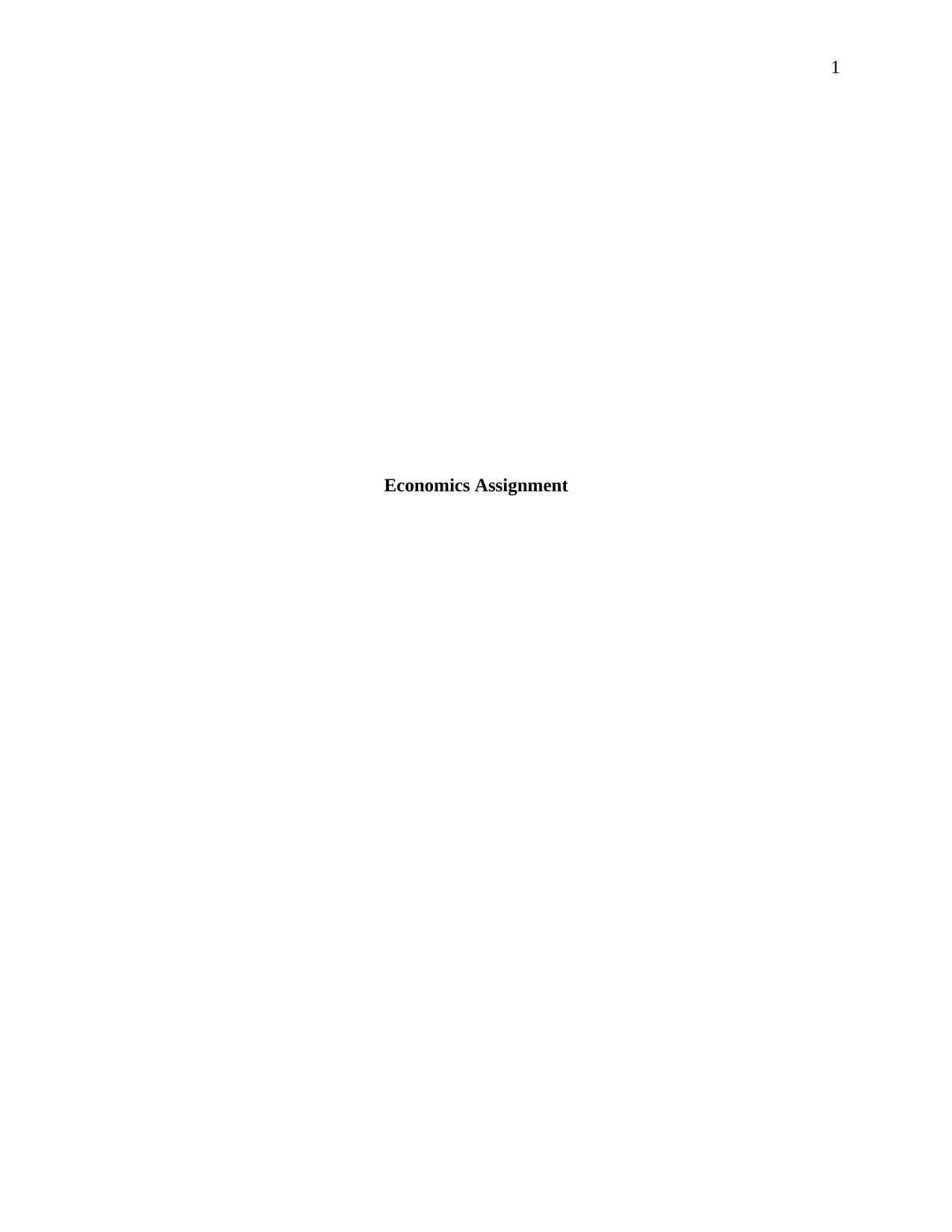
1
Economics Assignment
Economics Assignment
Paraphrase This Document
Need a fresh take? Get an instant paraphrase of this document with our AI Paraphraser
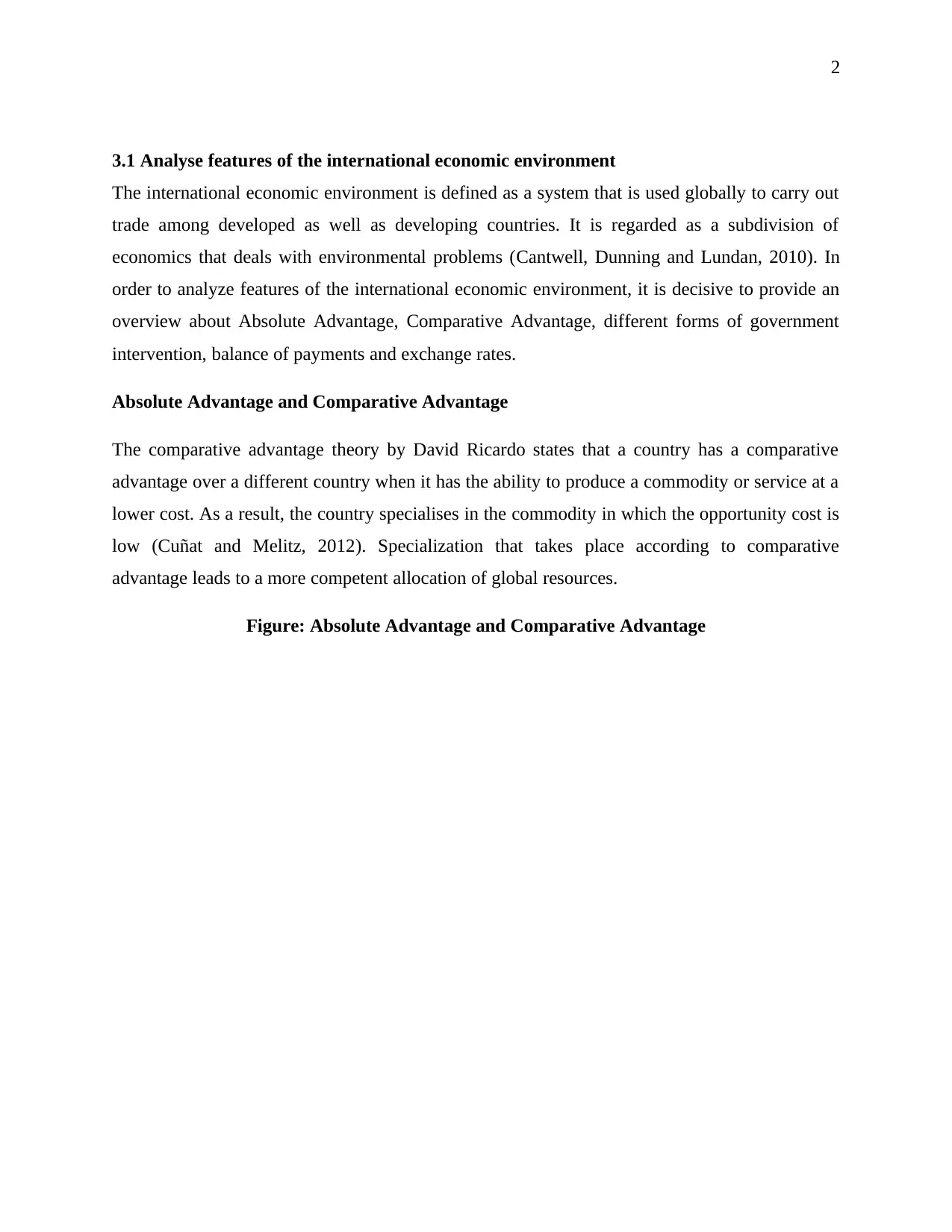
2
3.1 Analyse features of the international economic environment
The international economic environment is defined as a system that is used globally to carry out
trade among developed as well as developing countries. It is regarded as a subdivision of
economics that deals with environmental problems (Cantwell, Dunning and Lundan, 2010). In
order to analyze features of the international economic environment, it is decisive to provide an
overview about Absolute Advantage, Comparative Advantage, different forms of government
intervention, balance of payments and exchange rates.
Absolute Advantage and Comparative Advantage
The comparative advantage theory by David Ricardo states that a country has a comparative
advantage over a different country when it has the ability to produce a commodity or service at a
lower cost. As a result, the country specialises in the commodity in which the opportunity cost is
low (Cuñat and Melitz, 2012). Specialization that takes place according to comparative
advantage leads to a more competent allocation of global resources.
Figure: Absolute Advantage and Comparative Advantage
3.1 Analyse features of the international economic environment
The international economic environment is defined as a system that is used globally to carry out
trade among developed as well as developing countries. It is regarded as a subdivision of
economics that deals with environmental problems (Cantwell, Dunning and Lundan, 2010). In
order to analyze features of the international economic environment, it is decisive to provide an
overview about Absolute Advantage, Comparative Advantage, different forms of government
intervention, balance of payments and exchange rates.
Absolute Advantage and Comparative Advantage
The comparative advantage theory by David Ricardo states that a country has a comparative
advantage over a different country when it has the ability to produce a commodity or service at a
lower cost. As a result, the country specialises in the commodity in which the opportunity cost is
low (Cuñat and Melitz, 2012). Specialization that takes place according to comparative
advantage leads to a more competent allocation of global resources.
Figure: Absolute Advantage and Comparative Advantage
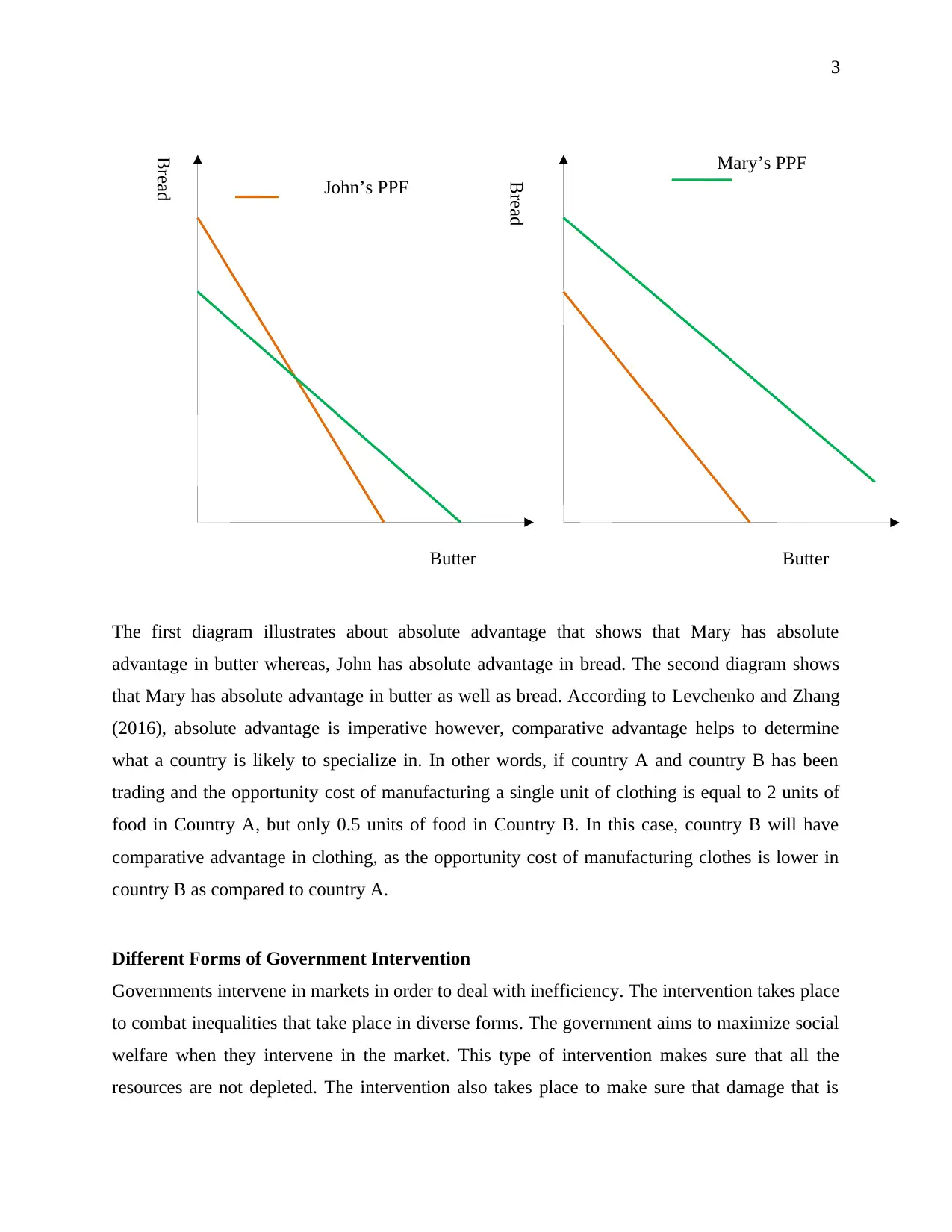
John’s PPF
Bread
Butter Butter
Bread
Mary’s PPF
3
The first diagram illustrates about absolute advantage that shows that Mary has absolute
advantage in butter whereas, John has absolute advantage in bread. The second diagram shows
that Mary has absolute advantage in butter as well as bread. According to Levchenko and Zhang
(2016), absolute advantage is imperative however, comparative advantage helps to determine
what a country is likely to specialize in. In other words, if country A and country B has been
trading and the opportunity cost of manufacturing a single unit of clothing is equal to 2 units of
food in Country A, but only 0.5 units of food in Country B. In this case, country B will have
comparative advantage in clothing, as the opportunity cost of manufacturing clothes is lower in
country B as compared to country A.
Different Forms of Government Intervention
Governments intervene in markets in order to deal with inefficiency. The intervention takes place
to combat inequalities that take place in diverse forms. The government aims to maximize social
welfare when they intervene in the market. This type of intervention makes sure that all the
resources are not depleted. The intervention also takes place to make sure that damage that is
Bread
Butter Butter
Bread
Mary’s PPF
3
The first diagram illustrates about absolute advantage that shows that Mary has absolute
advantage in butter whereas, John has absolute advantage in bread. The second diagram shows
that Mary has absolute advantage in butter as well as bread. According to Levchenko and Zhang
(2016), absolute advantage is imperative however, comparative advantage helps to determine
what a country is likely to specialize in. In other words, if country A and country B has been
trading and the opportunity cost of manufacturing a single unit of clothing is equal to 2 units of
food in Country A, but only 0.5 units of food in Country B. In this case, country B will have
comparative advantage in clothing, as the opportunity cost of manufacturing clothes is lower in
country B as compared to country A.
Different Forms of Government Intervention
Governments intervene in markets in order to deal with inefficiency. The intervention takes place
to combat inequalities that take place in diverse forms. The government aims to maximize social
welfare when they intervene in the market. This type of intervention makes sure that all the
resources are not depleted. The intervention also takes place to make sure that damage that is
⊘ This is a preview!⊘
Do you want full access?
Subscribe today to unlock all pages.

Trusted by 1+ million students worldwide

4
caused by naturally depleting economic circumstances is diminished. It also takes the form of
taxation as well as welfare programs in order to promote general economic equality. The
government also makes the use of price ceiling that helps to restrict a high price. The price
ceiling acts as a price control that protects customers of a particular commodity or service
(Bulkeley and Castán Broto, 2013). Rent control is regarded as a more popular example of price
ceiling that indicates rise in rent prices as compared to the market demand.
Balance of Payments and Exchange Rates
The change in balance of payment of a country is likely to bring about fluctuations in the
exchange rate between foreign currencies as well as domestic currency. Under fixed-rate system,
exchange rate is not affected by balance of payments (Gouvêa and Lima, 2010). This is because;
currency flows are adjusted by central banks that in turn counterbalance the global funds
exchange.
3.2 Analyse the economic implications for business of operating in a global business
environment
The international marketplace has been coupled with ubiquity of the internet that allows all
businesses to carry out their operations equally. In order to analyze the implications for business
of operating in a global business environment, it is decisive to reflect on purchasing power
parity, international risks evaluation of functioning in a global environment and less developed
countries. Purchasing power parity is an economic theory that provides a comparison between
currencies belonging to diverse countries through a basket of goods strategy (Zott, Amit and
Massa, 2011). This concept illustrates that two currencies are always at equilibrium.
Figure: Purchasing power parity
caused by naturally depleting economic circumstances is diminished. It also takes the form of
taxation as well as welfare programs in order to promote general economic equality. The
government also makes the use of price ceiling that helps to restrict a high price. The price
ceiling acts as a price control that protects customers of a particular commodity or service
(Bulkeley and Castán Broto, 2013). Rent control is regarded as a more popular example of price
ceiling that indicates rise in rent prices as compared to the market demand.
Balance of Payments and Exchange Rates
The change in balance of payment of a country is likely to bring about fluctuations in the
exchange rate between foreign currencies as well as domestic currency. Under fixed-rate system,
exchange rate is not affected by balance of payments (Gouvêa and Lima, 2010). This is because;
currency flows are adjusted by central banks that in turn counterbalance the global funds
exchange.
3.2 Analyse the economic implications for business of operating in a global business
environment
The international marketplace has been coupled with ubiquity of the internet that allows all
businesses to carry out their operations equally. In order to analyze the implications for business
of operating in a global business environment, it is decisive to reflect on purchasing power
parity, international risks evaluation of functioning in a global environment and less developed
countries. Purchasing power parity is an economic theory that provides a comparison between
currencies belonging to diverse countries through a basket of goods strategy (Zott, Amit and
Massa, 2011). This concept illustrates that two currencies are always at equilibrium.
Figure: Purchasing power parity
Paraphrase This Document
Need a fresh take? Get an instant paraphrase of this document with our AI Paraphraser
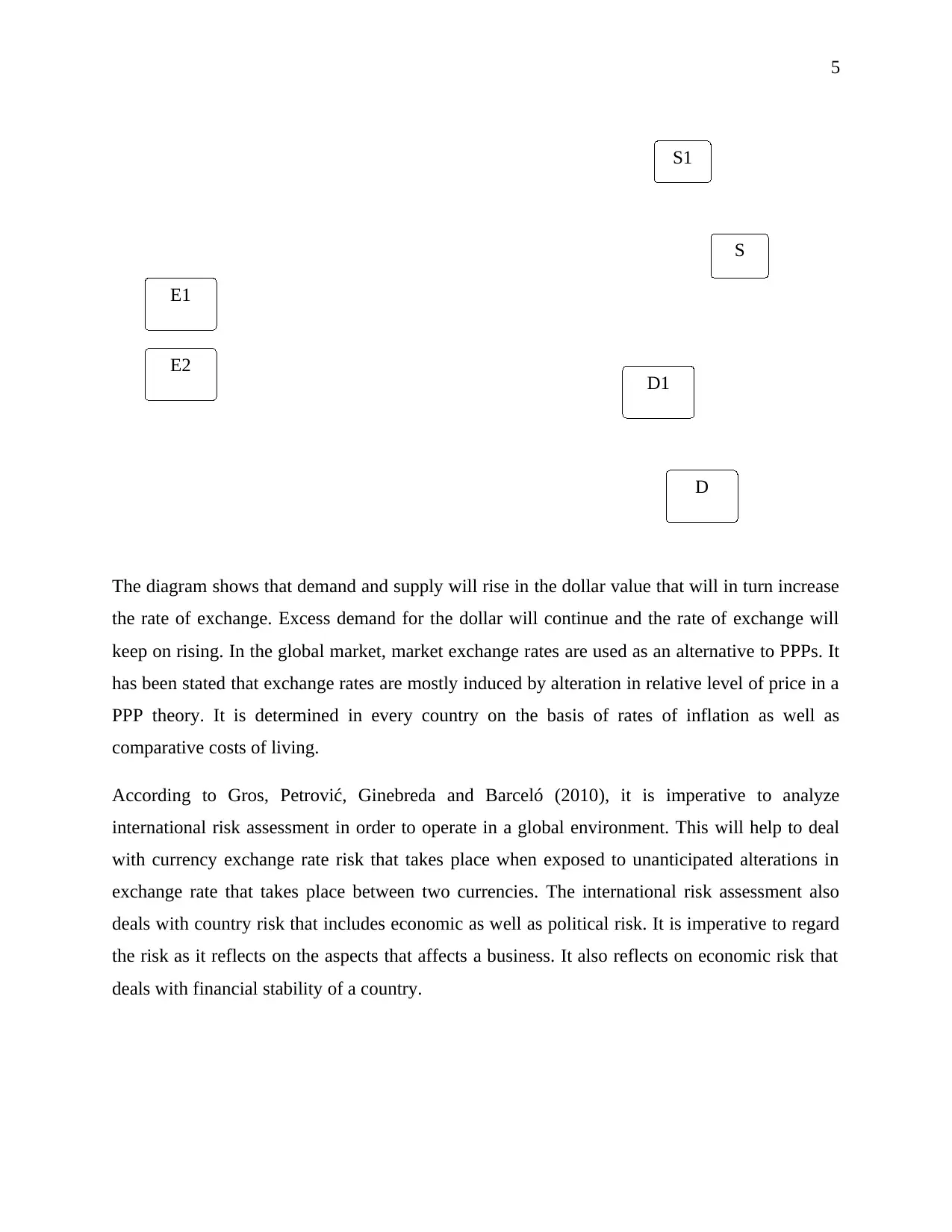
S1
S
D1
D
E1
E2
5
The diagram shows that demand and supply will rise in the dollar value that will in turn increase
the rate of exchange. Excess demand for the dollar will continue and the rate of exchange will
keep on rising. In the global market, market exchange rates are used as an alternative to PPPs. It
has been stated that exchange rates are mostly induced by alteration in relative level of price in a
PPP theory. It is determined in every country on the basis of rates of inflation as well as
comparative costs of living.
According to Gros, Petrović, Ginebreda and Barceló (2010), it is imperative to analyze
international risk assessment in order to operate in a global environment. This will help to deal
with currency exchange rate risk that takes place when exposed to unanticipated alterations in
exchange rate that takes place between two currencies. The international risk assessment also
deals with country risk that includes economic as well as political risk. It is imperative to regard
the risk as it reflects on the aspects that affects a business. It also reflects on economic risk that
deals with financial stability of a country.
S
D1
D
E1
E2
5
The diagram shows that demand and supply will rise in the dollar value that will in turn increase
the rate of exchange. Excess demand for the dollar will continue and the rate of exchange will
keep on rising. In the global market, market exchange rates are used as an alternative to PPPs. It
has been stated that exchange rates are mostly induced by alteration in relative level of price in a
PPP theory. It is determined in every country on the basis of rates of inflation as well as
comparative costs of living.
According to Gros, Petrović, Ginebreda and Barceló (2010), it is imperative to analyze
international risk assessment in order to operate in a global environment. This will help to deal
with currency exchange rate risk that takes place when exposed to unanticipated alterations in
exchange rate that takes place between two currencies. The international risk assessment also
deals with country risk that includes economic as well as political risk. It is imperative to regard
the risk as it reflects on the aspects that affects a business. It also reflects on economic risk that
deals with financial stability of a country.
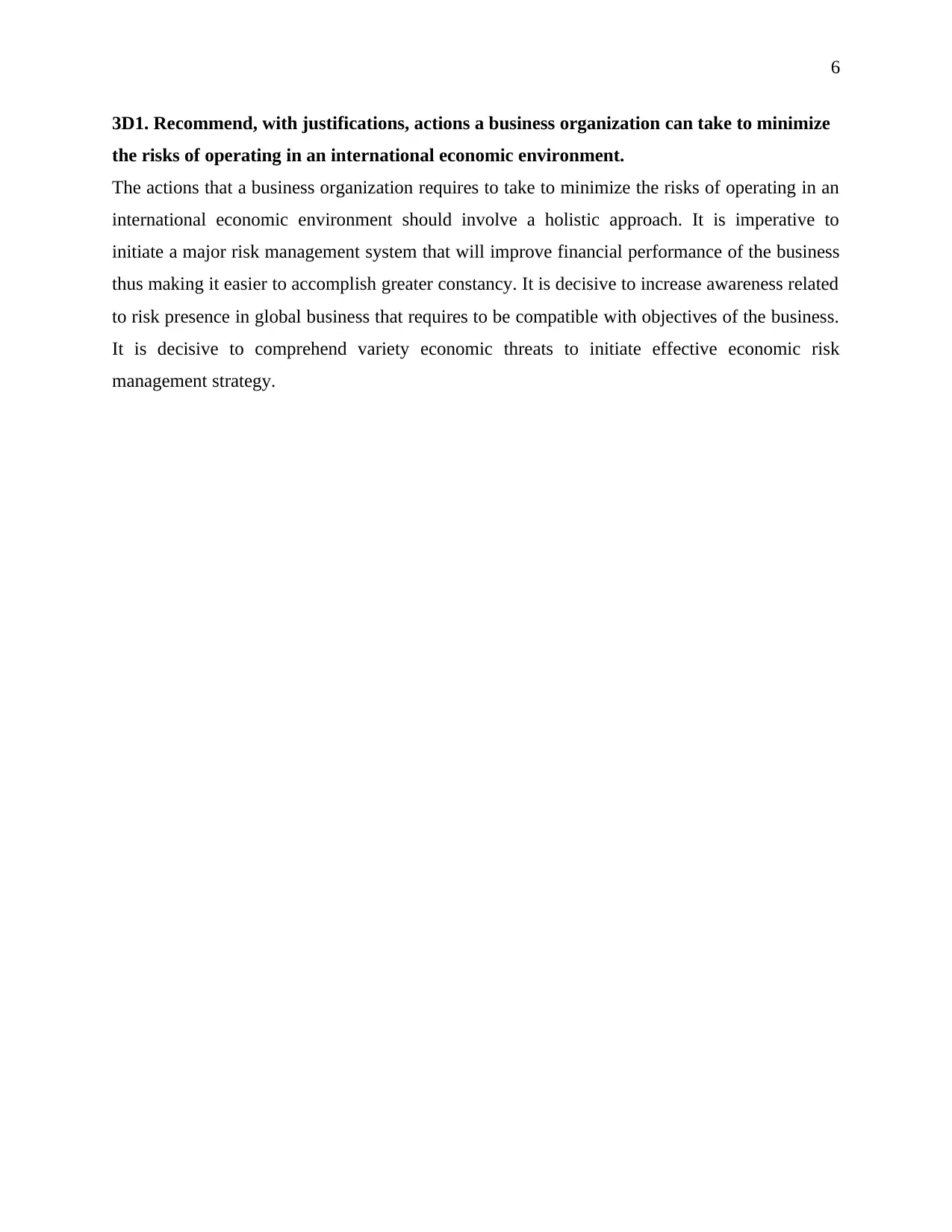
6
3D1. Recommend, with justifications, actions a business organization can take to minimize
the risks of operating in an international economic environment.
The actions that a business organization requires to take to minimize the risks of operating in an
international economic environment should involve a holistic approach. It is imperative to
initiate a major risk management system that will improve financial performance of the business
thus making it easier to accomplish greater constancy. It is decisive to increase awareness related
to risk presence in global business that requires to be compatible with objectives of the business.
It is decisive to comprehend variety economic threats to initiate effective economic risk
management strategy.
3D1. Recommend, with justifications, actions a business organization can take to minimize
the risks of operating in an international economic environment.
The actions that a business organization requires to take to minimize the risks of operating in an
international economic environment should involve a holistic approach. It is imperative to
initiate a major risk management system that will improve financial performance of the business
thus making it easier to accomplish greater constancy. It is decisive to increase awareness related
to risk presence in global business that requires to be compatible with objectives of the business.
It is decisive to comprehend variety economic threats to initiate effective economic risk
management strategy.
⊘ This is a preview!⊘
Do you want full access?
Subscribe today to unlock all pages.

Trusted by 1+ million students worldwide
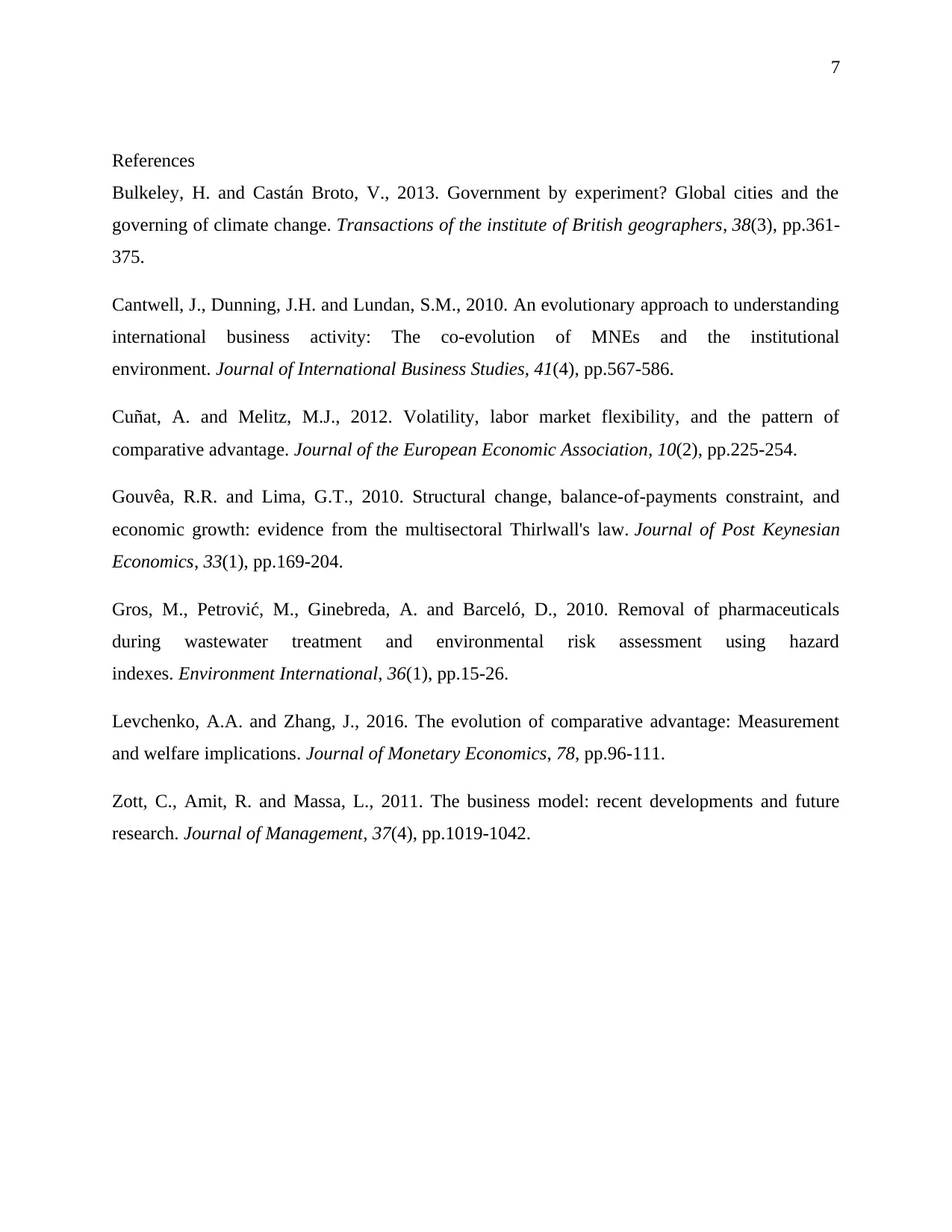
7
References
Bulkeley, H. and Castán Broto, V., 2013. Government by experiment? Global cities and the
governing of climate change. Transactions of the institute of British geographers, 38(3), pp.361-
375.
Cantwell, J., Dunning, J.H. and Lundan, S.M., 2010. An evolutionary approach to understanding
international business activity: The co-evolution of MNEs and the institutional
environment. Journal of International Business Studies, 41(4), pp.567-586.
Cuñat, A. and Melitz, M.J., 2012. Volatility, labor market flexibility, and the pattern of
comparative advantage. Journal of the European Economic Association, 10(2), pp.225-254.
Gouvêa, R.R. and Lima, G.T., 2010. Structural change, balance-of-payments constraint, and
economic growth: evidence from the multisectoral Thirlwall's law. Journal of Post Keynesian
Economics, 33(1), pp.169-204.
Gros, M., Petrović, M., Ginebreda, A. and Barceló, D., 2010. Removal of pharmaceuticals
during wastewater treatment and environmental risk assessment using hazard
indexes. Environment International, 36(1), pp.15-26.
Levchenko, A.A. and Zhang, J., 2016. The evolution of comparative advantage: Measurement
and welfare implications. Journal of Monetary Economics, 78, pp.96-111.
Zott, C., Amit, R. and Massa, L., 2011. The business model: recent developments and future
research. Journal of Management, 37(4), pp.1019-1042.
References
Bulkeley, H. and Castán Broto, V., 2013. Government by experiment? Global cities and the
governing of climate change. Transactions of the institute of British geographers, 38(3), pp.361-
375.
Cantwell, J., Dunning, J.H. and Lundan, S.M., 2010. An evolutionary approach to understanding
international business activity: The co-evolution of MNEs and the institutional
environment. Journal of International Business Studies, 41(4), pp.567-586.
Cuñat, A. and Melitz, M.J., 2012. Volatility, labor market flexibility, and the pattern of
comparative advantage. Journal of the European Economic Association, 10(2), pp.225-254.
Gouvêa, R.R. and Lima, G.T., 2010. Structural change, balance-of-payments constraint, and
economic growth: evidence from the multisectoral Thirlwall's law. Journal of Post Keynesian
Economics, 33(1), pp.169-204.
Gros, M., Petrović, M., Ginebreda, A. and Barceló, D., 2010. Removal of pharmaceuticals
during wastewater treatment and environmental risk assessment using hazard
indexes. Environment International, 36(1), pp.15-26.
Levchenko, A.A. and Zhang, J., 2016. The evolution of comparative advantage: Measurement
and welfare implications. Journal of Monetary Economics, 78, pp.96-111.
Zott, C., Amit, R. and Massa, L., 2011. The business model: recent developments and future
research. Journal of Management, 37(4), pp.1019-1042.
1 out of 7
Your All-in-One AI-Powered Toolkit for Academic Success.
+13062052269
info@desklib.com
Available 24*7 on WhatsApp / Email
![[object Object]](/_next/static/media/star-bottom.7253800d.svg)
Unlock your academic potential
Copyright © 2020–2025 A2Z Services. All Rights Reserved. Developed and managed by ZUCOL.